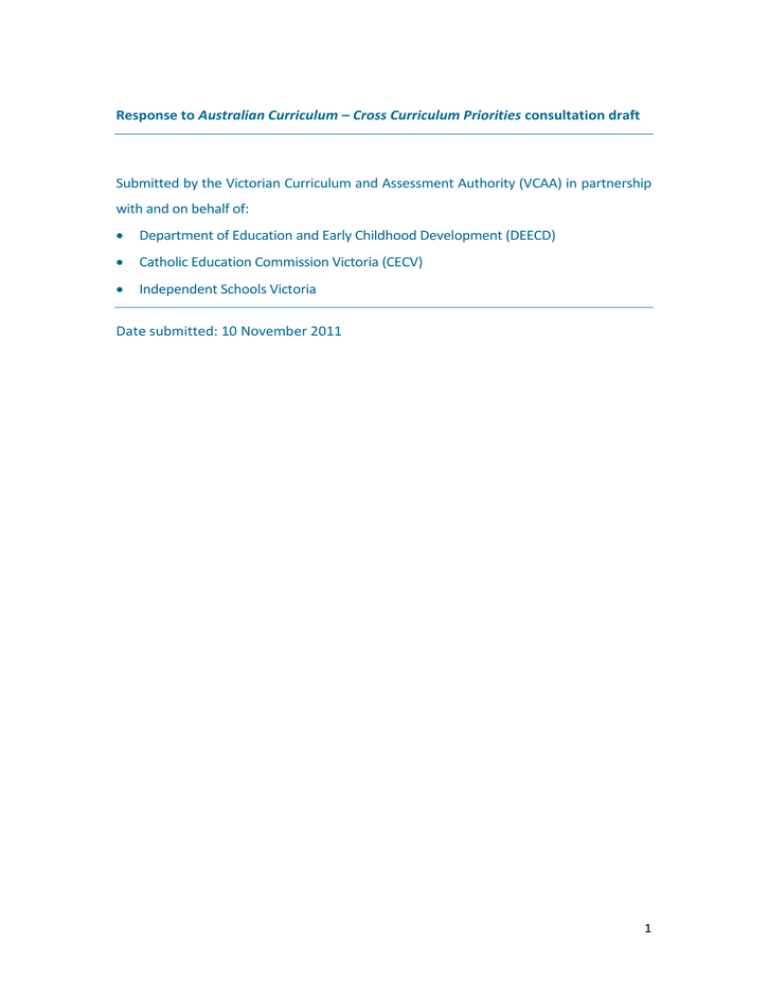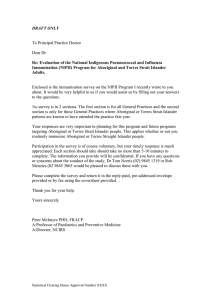Cross Curriculum Priorities consultation draft
advertisement

Response to Australian Curriculum – Cross Curriculum Priorities consultation draft Submitted by the Victorian Curriculum and Assessment Authority (VCAA) in partnership with and on behalf of: Department of Education and Early Childhood Development (DEECD) Catholic Education Commission Victoria (CECV) Independent Schools Victoria Date submitted: 10 November 2011 1 1. Introduction The Victorian Curriculum and Assessment Authority (VCAA), in partnership with the Department of Education and Early Childhood Development (DEECD), the Catholic Education Commission Victoria (CECV) and Independent Schools Victoria, welcomes the opportunity to provide comment on the Australian Curriculum – Cross Curriculum Priorities consultation draft. This response is informed by consultation undertaken with Victorian stakeholders in relation to the Sustainability and Asia and Australia’s Engagement with Asia priorities, and with the Victorian Aboriginal Education Association Inc. (VAEAI) and Victorian Aboriginal Corporation for Languages (VACL) in relation to the Aboriginal and Torres Strait Islanders, histories and cultures priority. Victoria strongly supports the inclusion of these priorities in the Australian Curriculum. These priorities highlight knowledge and skills that is crucial for all young Australians, and illustrate how learning can be integrated across the subjects to enable and ensure students connect their learning with important issues in contemporary society. As VAEAI note in their independent submission: [The] mandatory inclusion of Aboriginal and Torres Strait Islander (ATSI) perspectives in the education of all Australian children … will be an integral step towards reconciliation and addressing Indigenous disadvantage … engagement with the world’s oldest continuous living culture enriches the ability of all learners to participate positively to the ongoing development of Australia. We support the curriculum design that positions these priorities not as separate areas of learning, but as integral to the learning areas of the Australian Curriculum. A key test, therefore, of the curriculum is that there should no curriculum content located under the cross curriculum priorities that is additional to the curriculum content defined in the learning ares. 2. Key issues The organising ideas for each priority do present a cohesive description of each Cross Curriculum Priority. However, three are three key issues that we believe warrant further attention. The first is that a list of the key skills and knowledge associated with each of the priorities that it is essential every young Australian should acquire should be developed and used to audit the existing curriculum to determine either (a) whether these areas of key skills and knowledge have been included in the content of the learning areas or (b) whether they should be included in the content of the learning areas still to be developed. 2 The second relates to the use of icons to signify the place of the priorities across the curriculum. The use of icons in their current form leads to a highly superficial, tokenistic approach where an icon appears next to particular word or phrase within a curriculum area or strand instead of being associated with deeper skills. For example, in Science the sustainability icon appears with content where the term ecosystem or earth is used but not against predictions, data collection and analysis, all of which are key skills necessary for students to develop in order to be able to engage in the crucial issues associated with sustainabilitiy. A more judicious placement of icons or other form of linkage is required to reflect how the Cross Curriculum Priorities are linked to the curriculum content, with an explanation that the placement of the icons provides examples rather than a comprehensive coverage of the skills and knowledge associated with each priority. The third is the key issue raised in the VAEAI response in relation to the Aboriginal and Torres Strait Islanders, histories and cultures priority, that is, that: much of the vocabulary used within the draft priorities information presents Indigenous Australians and their cultures as exotic and/or primitive and, therefore, as ‘other’. Presenting any group of peoples in this way is a form of subordination, and functions to exclude ATSI peoples from mainstream society. ‘Othering’ also perpetuates the creation and maintenance of an ideology of race that that contributed to the justification of the behaviours of European colonisers towards Indigenous peoples. We support the recommendation that the language used to describe this priority be modified to acknowledge the importance of Aboriginal and Torres Strait Islander histories, cultures and perspectives alongside the other histories, cultures and perspectives that together constitute contemporary Ausralia, without positioning Aboriginal and Torres Strait Islanders, histories and cultures as ‘exotic’ or ‘primitive’. 3. Detailed recommendations: Revisions to Organising Ideas (a) Asia and Australia’s engagement with Asia OI 1 2 5 Feedback Reference to ‘countries’ here is limiting. Diversity of languages and cultural (and influences on cultures) within particular Asian countries is not evident The use of the terms ‘environment’ and ‘influence’ requires clarification. Suggested change Replace with ‘cultures’ to encompass the diversity that occurs within a country/region. Use a glossary to indicate that languages and cultural can include political, linguistic or geographic Use a glossary to indicate that environments can include economic, social or physical, and that influence can refer to local or global dimensions The use of the term ‘good’ is not Replace ‘good’ with ‘active’ and/or appropriate. ‘informed’ or ‘responsible’ 3 (b) Sustainability OI 1 Comment Recommendation For OI 1-4 if term system(s) used then Definition of what a ‘system’ is and title needs changing how it relates to sustainability is required. This would assist with the choice of a more suitable heading for the set of organising ideas 1-4. 2 Use of term ‘connected’ 3 5 6 7 8 9 10 Replace ‘connected’ with ‘interdependence’ Use of term ‘closely related’ Replace ‘closely related’ with ‘interdependence’ World view is a dated term Replace world view with global view/perspective As printed this is a restatement of OI5 Remove Include maintain and promote with ‘intervene’ and add ‘cultural’ What are ‘products’? Add ‘consume’ and ‘services’ Use glossary to provide examples of ‘products’ OI9 an OI10 are very similar and are Add ‘services’ and ‘technology’ to not related to futures provide a futures focus remove (c) Aboriginal and Torres Strait Islanders, histories and cultures We note and broadly support the recommendations made in the VAEI response, in particular that caution should be used to ensure that exercises related to the use of statistical data do not position Aboriginal and Torres Strait Islander Peoples as scientific or mathematical ‘curiosities’, and that the specific knowledge of Aboriginal and Torres Strait Islander peoples in Australian society that students should develop should be more clearly specified. 4



